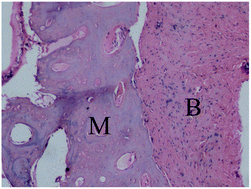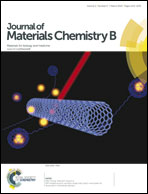Development of a bioactive composite of nano fluorapatite and poly(butylene succinate) for bone tissue regeneration
Abstract
The development of a bioactive nanocomposite for bone replacement has gained much interest in the field of bone grafting. In this study, a nano fluorapatite (n-FA)–poly(butylene succinate) (PBS) bioactive composite was fabricated using a co-solution method. The results showed that the n-FA–PBS composite had improved hydrophilicity, compressive strength and an elastic modulus, which were obviously higher than those of PBS alone. In addition, the n-FA–PBS composite could inhibit bacterial attachment, with the number of viable bacteria on the composite obviously lower than on pure PBS, indicating good antibacterial ability. Moreover, the attachment and proliferation of human mesenchymal stem cells (hMSCs) on the n-FA–PBS composite was significantly higher than on PBS, and the alkaline phosphatase (ALP) activity of hMSCs on the composite was expressed at significantly higher levels compared to PBS. Furthermore, the hMSCs showed intimate contact with the composite surface and the cells spread and grew significantly better on the composite compared to PBS. Therefore, incorporation of n-FA into PBS is a good way to prepare an inorganic–organic bioactive composite of a nano ceramic and a polymer, which supports cell attachment, proliferation and differentiation. The implantation of the n-FA–PBS composite into the femoral bone of rabbits confirmed that the new bone tissue could form on the composite surfaces, and the composite combined directly with the natural bone tissue without fibrous capsule tissue, showing good osteoconductivity. In short, the n-FA–PBS bioactive composite has good biocompatibility and bioactivity, and has potential application in bone regeneration.


 Please wait while we load your content...
Please wait while we load your content...